The
Home Page Selection
If
you require further information on any
print featured here, please contact
us.
When
a print has been sold it will be marked
as Sold.
A
growing archive of selections
from previous Home pages is featured in
the
Home
Page Selection Archive |
|
See
also :
Click
on a thumbnail (left)
to link directly with the entry for that
print, or scroll down to view all the selected
prints from the current Home
Page.
Images
are not to relative scale (see stated dimensions) and also at only modest resolution.
If you wish to view extracts of an image at higher resolution, please Contact us.
|
|
|
|
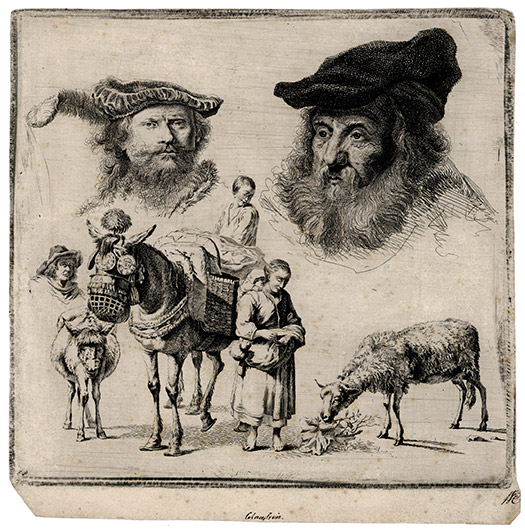
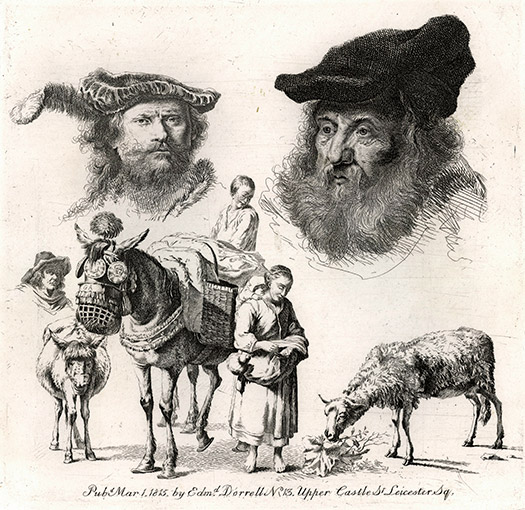
|
|
Chevalier IGNACE JOSEPH DE CLAUSSIN
Lunéville, Lorrain 1766 – 1844 Paris
De Claussin was an amateur etcher inspired by his avid admiration for Rembrandt, whose etchings and drawings he studied and collected. In 1824 he produced a Catalogue Raisonné des estampes qui forment l’Oeuvre de Rembrandt.
His own etchings are mainly copies after Rembrandt and other Dutch masters. Four of his Rembrandt copies were included in the 1810 posthumous re- issue of the Recueil Basan.
De Claussin lived in London during the last years of the 18th century and the first decades of the 19th century. In 1815 Edmund Dorrell published a collection of eighteen of de Claussin’s etchings, re-printed specially for the book, including the sheet of Four Studies offered here.
(Four Studies)
209 x 220 mm
Etching, 1807, including a reverse copy after Rembrandt (Self-portrait in a velvet cap with plume), and three by Dujardin and others. An early impression on soft wove, trimmed to the inked plate bevel on three sides.
Ex collection William Esdaile (1758-1837) (Lugt 2617). Also with initials FP recto and an unidentified name in script verso.
Together with a later impression, the plate re-printed in 1815, for the book A Collection of Etchings, consisting of eighteen plates after Berghem, Bloemart, Boisseau, Brown, Potter, Rembrandt, Worlidge &c by Joseph de Claussin, London published February 20th, 1815, by Edmund Dorrell, No.13 Castle Street, Leicester Square, W Pople, Printer, 67 Chancery Lane.
On wove with margins.
£120
Return to top ^ |
|
|
|
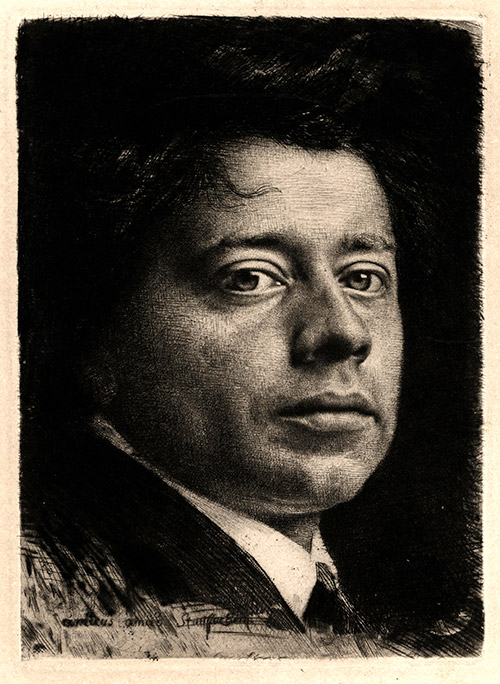
|
|
KARL STAUFFER-BERN
Trubschachen, Bern 1857 – 1891 Florence
Stauffer-Bern studied at the Academy in Munich, where he met fellow student Peter Halm and they became good friends.
Stauffer-Bern moved to Berlin in the early 1880’s, where he worked as a portrait painter, and also taught at the Berlin School for Women Artists, Käthe Kollwitz being one of his students. (He introduced her to the graphic work of Klinger which had a huge impact on her development.)
Richard Strauss’ tone poem An Alpine Symphony when he initially began work on it in 1899, was entitled Künstlertragödie (Tragedy of an Artist) in memory of Stauffer-Bern, who had a sad ending.
This piece fell by the wayside but Strauss used parts of it in the Alpine Symphony.
Stauffer-Bern etched at least four portrait heads of his friend Peter Halm.
Portrait of Peter Halm
Lehrs 10 v/v
218 x 158 mm
Original etching and drypoint, 1886.
The plate signed and annotated amicus amico (friend to friend).
A figure 2 blindstamped in the bottom left corner.
On dark cream textured wove.
Sold
Return to top ^ |
|
|
|
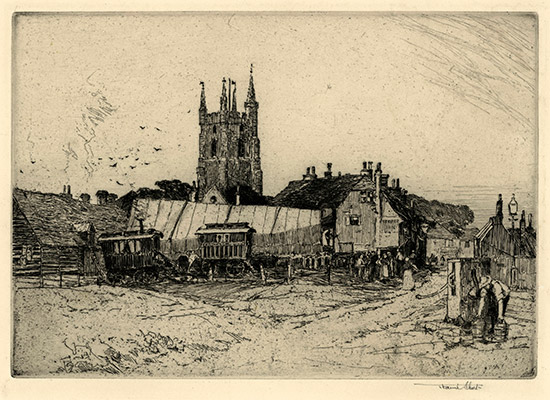 |
|
FRANK SHORT R.A., P.R.E.
Wollaston, Worcs. 1857 – 1945 Ditchling
Strolling Players, Lydd
Hardie 335 ii/ii
175 x 253 mm
Original etching, 1907.
The plate signed with the shield and initial S.
Signed in pencil.
On cream wove..
£200
Return
to top ^ |
|
|
|
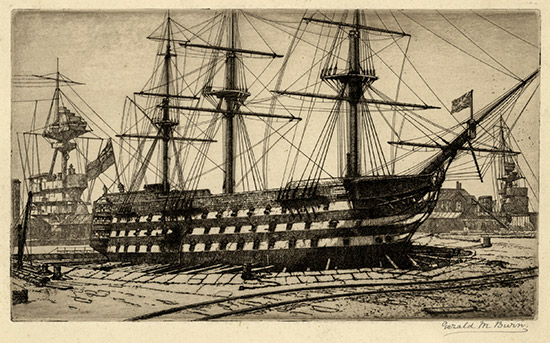 |
|
GERALD MAURICE BURN
Hammersmith, London 1859 – 1945 Amberley, Sussex
A painter and etcher of marine & architectural subjects, Burn studied at South Kensington, and later in Germany, Belgium and France.
In 1907 he settled in Amberley, Sussex.
Burn exhibited at the R.A., the R.B.A., The Walker, Liverpool and the Portsmouth & Hampshire Art Society.
HMS Victory
110 x 187 mm
Original etching.
Signed in pencil.
On cream wove.
£120
Return to top ^ |
|
|
|
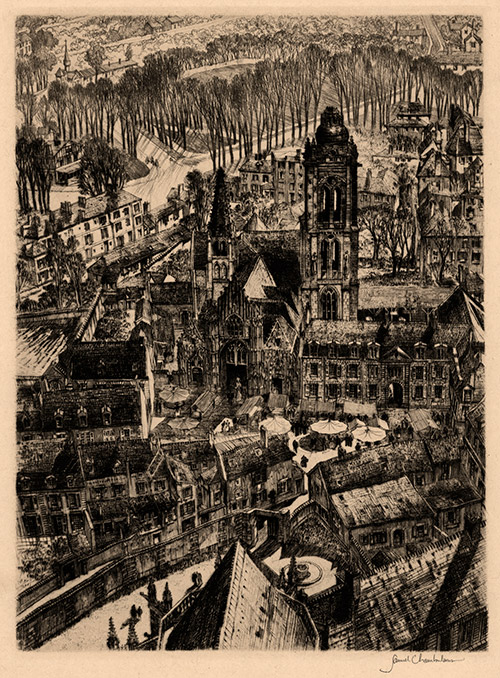 |
|
SAMUEL CHAMBERLAIN
Cresco, Iowa 1895 – 1975 Marblehead, Massachusetts
Ultimately printmaker, photographer and writer, in 1913 Chamberlain enrolled in the University of Washington, Seattle to study architecture, moving in 1915 to the School of Architecture of the Massachusetts Institute of Technology.
When the United States became involved in the first World War Chamberlain sailed to France and volunteered in the American Field Service and in 1918 was transferred to the U.S. Army.
After the War he returned to Boston to resume his architectural studies, before changing direction. An American Field Service travelling scholarship in 1923 took him to Spain, North Africa and Italy, and, in 1924 in Paris, he took up printmaking, studying lithography and etching. He published his first etching in 1925. In 1927 he studied drypoint with Malcolm Osborne at the R.C.A. in London.
Back in America he was a member of the American Academy of Arts and Sciences; the American Institute of Architects; the American Society of the French Legion of Honor; the Boston Camera Club; the Boston Printmakers; the Chicago Society of Etchers;Photographic Society of America; the Print Club of Albany; the Society of American Etchers; and was elected an Academician in the National Academy of Design.
His publications included This Realm, this England: the Citadel of a valiant Race portrayed by its greatest Etchers as well as a regular column for Gourmet Magazine, under the pseudonym of ‘Phineas Beck’ (from the French colloquialism for a gourmand bec fin).
Early Morning Market, Senlis
Chamberlain & Kingsland 273;
Boston Public Library
273
230 x 170 mm
Original drypoint, 1939.
Signed in pencil.
Edition of 300.
Printed in brown-black ink on thin cream wove.
£250
Return to top ^ |
|
|
|
|
|
|
|